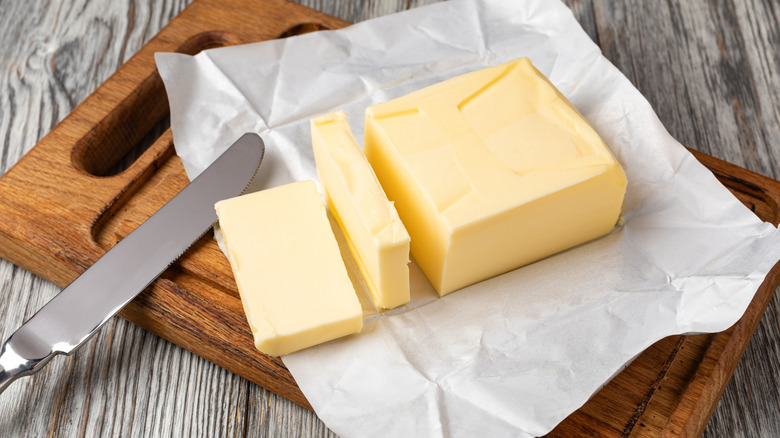The One Simple Ingredient That Will Instantly Elevate Your Meatloaf's Flavor
Meatloaf is one of the more divisive dishes to come out of the Depression era, often dismissed as mystery meat and eyed with suspicion. Yet that reputation is undeserved; born of innovation, there's a reason it's long endured past the days of rationing — unlike a certain depression-era cake we don't see people eating anymore. In truth, meatloaf is an economical, versatile dish, and there are plenty of ingredients that can seriously upgrade your homemade one. One ingredient that can wow even the staunchest meatloaf skeptic is butter. To find out how this humble ingredient can instantly elevate your meatloaf's texture and flavor, Food Republic spoke with John Politte, owner and executive chef of It's Only Food.
From topping pancakes to Japanese-style fried rice, butter is no stranger to adding new depths of flavor and texture. According to Politte, "Butter adds a creamy richness and subtle sweetness from caramelized milk solids, blending seamlessly with the savory meat and seasonings for a deeper, more balanced flavor."
He explained, "Adding butter to meatloaf creates a richer flavor and a tender, moist texture, making it superior to relying only on meat fat." Typically, meatloaf is usually made from lean ground beef, but can also be made from other meats such as turkey, lamb, or pork. Lean beef means that it does not contain a high percentage of natural fats — just compare a lean cut of steak, like sirloin, to a fattier cut like ribeye. During high-heat cooking, there's less natural fat to keep the meat moist by rendering out and basting the meat, which can cause it to go dry and tough while losing the rich flavors of the fat. That's why butter is such a game-changer. "Butter melts evenly, coating and tenderizing the loaf," Politte explained. "This results in a moist, soft texture."
How to incorporate butter into your meatloaf
Meatloaf is simple to make; just combine your ground meat with binders, seasonings, and an optional homemade glaze. When it comes to adding butter, there are two ways to incorporate it: directly into the mixture or with the glaze.
"For the best results, add small pieces of cold butter to the mixture for juiciness, and spread a thin layer on top for a rich, golden crust," John Politte told us. He also recommended using unsalted butter and to "chill before grating or dicing" to make the job easier. Make sure the butter is evenly distributed, so it melts uniformly throughout the meatloaf, coating it consistently as it cooks. The butter on top will help retain moisture and create a beautiful golden-brown crust with a nutty flavor through the Maillard reaction. To make a butter-based glaze, simply melt it in the microwave or skillet and then brush it over the meat with a silicone pastry brush.
"Try mixing herbs or spices into the butter for extra flavor," Politte suggested. This is a great way to customize your meatloaf to suit your personal taste. To make a compound butter, soften it slightly and mix in your herbs and seasonings of choice. Classic options include roasted garlic butter or an herby French-inspired green tarragon butter, or for a spicy kick, you could also make a creamy Korean-inspired gochujang butter.
How to prevent your meatloaf going overly greasy.
Butter is a practical and delicious addition to meatloaf, enhancing both texture and flavor, but remember — moderation is key, and you shouldn't get carried away. "It may also make the dish greasy," John Politte told us. "Excess butter can cause oil to pool in the pan," a sight that can quickly ruin any appetite. For the perfect meatloaf, you'll want to ensure that you've got a balanced lean-to-fat ratio – we suggest 80/20.
According to Politte, the amount of butter you use should depend on the meat's fat content. If you're working with lean meats, it's fine to add a little extra butter. But if you're using high-fat meats like pork or ground chuck, go lighter as the natural fats already provide the same richness that butter adds, making more fat unnecessary. To prevent greasiness, Politte also suggested chilling the loaf before baking. This helps the fats in both the butter and the meat stay solid, so they melt more gradually rather than all at once, allowing the loaf to hold its shape and distribute the fats more evenly. Another commonly used trick is to line the bottom of your pan with a slice of thick white bread, which will act like a sponge and absorb any excess grease. You could also bake it on a rack in order to let the fat drain away.
"Too much butter can weaken the loaf's shape, making it crumbly," Politte added. To maintain a firm texture, he recommended to "use binders like eggs or breadcrumbs," and to "keep butter to two to four tablespoons per recipe."



